 Global| Oct 29 2020
Global| Oct 29 2020Massive Rebound in Q3 GDP but Still Has Further to Go
by:Sandy Batten
|in:Economy in Brief
Summary
• After record decline in Q2, GDP posted record increase in Q3. • Led by rebounds in consumption and fixed investment. • But level of GDP still 3.5% below previous peak level. • Prices bounce back after having declined in Q2. U.S. GDP [...]
• After record decline in Q2, GDP posted record increase in Q3.
• Led by rebounds in consumption and fixed investment.
• But level of GDP still 3.5% below previous peak level.
• Prices bounce back after having declined in Q2.
U.S. GDP rebounded sharply in Q3, rising 33.1% q/q saar following a 31.4% q/q plunge in Q2 and a 5.0% drop in Q1. The Q3 rise and the Q2 decline were the largest increase and largest decline of the postwar period. Quarterly GDP began in 1947. The Action Economics Forecast Survey had expected a 31.9% jump. It should be noted that even though the percentage rebound in Q3 was larger than the percentage decline in Q2, the level of GDP in Q3 was still 2.2% lower than in Q1 and 3.5% below the peak in 2019 Q4. This reflects the base effect in calculating percentage changes. Compared with a year ago, real GDP was down 2.9% with personal consumption 2.9% lower and nonresidential fixed investment 5.0% lower while residential investment is 6.6% higher.
The Q3 report was almost the mirror image of the Q2 report. The Q2 collapse in GDP was led by household consumption and fixed investment. Similarly, the Q3 rebound was led by the same two sectors. Household consumption soared 40.7% q/q saar after a 33.2% drop in Q2. Fixed investment rebounded 28.5% after a 29.2% decline in Q2, reflecting a 20.3% rise in nonresidential investment (-27.2% in Q2) and a 59.3% surge in residential investment (-35.5% in Q2). Inventories fell a bit more in Q3 but this paled in comparison to the collapse in Q2; so inventories actually contributed 6.6%-points to overall growth. With imports (+91.1%) rebounding nearly 50% more than exports (+59.7%) in Q3, the trade deficit widened markedly in Q3 after having narrowed in Q2 with net exports subtracting 3.1%-points from overall growth.
Consumer spending continues to be a Jeckle and Hyde with spending on goods soaring while spending on services, while recovering, remaining historically depressed. Spending on goods exploded 45.4% in Q2, completely eclipsing the 10.8% decline in Q2, and ended Q3 6.7% above its previous peak. In contrast, though spending on services rebounded 38.4% in Q3, it fell far short of reversing the unprecedented 41.8% plunge in Q2. Spending on services is till 7.7% below its previous peak.
The rebound in nonresidential fixed investment was all in spending on equipment, which jumped up 70.1% in Q3 after falling 35.9% in Q2. Spending on structures fell 14.6%, led by a marked decline in oil and gas drilling, on top of a 33.6% drop in Q2 and spending on intellectual property products edged down 1.0% following a 11.4% decline in Q2. The strength in equipment spending was widely spread, led by a 258.5% saar surge in transportation equipment. That spending had cratered in both Q1 and Q2; so, even with the Q3 surge, spending on transportation equipment is still 22% below its level in 2019 Q4. The marked rebound in residential investment in Q3 recouped all of the output lost from the peak with Q3 residential spending 5% higher that the level in 2019 Q4 (the peak of the previous business cycle).
Inventory investment remained historically weak in Q3 with real inventories falling $1.0 billion (in 2012$). However, that paled in comparison to the $287 billion (2012$) plunge in Q2. So, inventories added 6.6%-points to overall growth in Q3. Moreover, the continued weakness in inventories could be good news for growth over the next couple of quarters as firms attempt to rebuild inventories to more normal levels.
Both exports and imports rebounded in Q3 with exports rising 59.7% following a 64.4% drop in Q2. Imports also rebounded but much more than did exports, jumping up 91.1% in Q3 after a 54.1% decline in Q2. As a result, the net exports deficit widened markedly to a record $1.0 trillion (2012$) and subtracted 3.1%-points from overall growth.
Government spending also subtracted from overall GDP growth in Q3 with spending at all levels of government falling 4.5% after having risen 2.5% in Q2. Spending by cash-strapped state and local governments declined 3.3% in Q3 on top of a 5.4% drop in Q2. But the big decline was in in nondefense spending by the federal government which slumped 18.1% in Q3, reversing a 37.6% surge in Q2 which had reflected the increased spending contained in the CARES Act.
The Q2 deflation (as measured by the GDP price index) was short lived with the price index jumping up 3.6% in Q3 after falling 1.8% in Q2. The reversal was led by a similar increase in the personal consumption expenditure price index, which rose 3.7% in Q3 after a 1.6% fall in Q2, reflecting a rebound in goods prices.
The GDP figures can be found in Haver's USECON and USNA database. USNA contains virtually all of the Bureau of Economic Analysis' detail in the national accounts. Both databases include tables of the newly published not seasonally adjusted data. The Action Economics consensus estimates can be found in AS1REPNA.
| Chained 2012 $ (%, AR) | Q3'20 (Adv) | Q2'20 | Q1'20 | Q4'19 | Q3'20 Y/Y | 2019 | 2018 | 2017 |
|---|---|---|---|---|---|---|---|---|
| Gross Domestic Product | 33.1 | -31.4 | -5.0 | 2.4 | -2.9 | 2.2 | 3.0 | 2.3 |
| Inventory Effect (%-point) | 6.6 | -3.5 | -1.3 | -0.8 | -0.2 | 0.0 | 0.2 | 0.0 |
| Final Sales | 25.5 | -28.1 | -3.6 | 3.2 | -2.7 | 2.2 | 2.8 | 2.4 |
| Foreign Trade Effect (%-point) | -3.1 | 0.6 | 1.1 | 1.5 | -0.4 | -0.2 | -0.3 | -0.2 |
| Domestic Final Sales | 29.2 | -27.1 | -4.6 | 1.6 | -2.3 | 2.3 | 3.0 | 2.5 |
| Demand Components | ||||||||
| Personal Consumption Expenditure | 40.7 | -33.2 | -6.9 | 1.6 | -2.9 | 2.4 | 2.7 | 2.6 |
| Nonresidential Fixed Investment | 20.3 | -27.2 | -6.7 | -0.3 | -5.0 | 2.9 | 6.9 | 3.7 |
| Residential Investment | 59.3 | -35.5 | 19.0 | 5.8 | 6.6 | -1.7 | -0.6 | 4.0 |
| Government Spending | -4.5 | 2.5 | 1.3 | 2.4 | 0.4 | 2.3 | 1.8 | 0.9 |
| Chain-Type Price Index | ||||||||
| GDP | 3.6 | -1.8 | 1.4 | 1.4 | 1.1 | 1.8 | 2.4 | 1.9 |
| Personal Consumption Expenditure | 3.7 | -1.6 | 1.3 | 1.5 | 1.2 | 1.5 | 2.1 | 1.8 |
| Less Food & Energy | 3.5 | -0.8 | 1.6 | 1.3 | 1.4 | 1.7 | 2.0 | 1.7 |
| Nonresidential Investment | 0.2 | 0.8 | 1.0 | -0.4 | 0.4 | 1.3 | 0.9 | 0.9 |
| Residential Investment | 9.6 | 1.0 | 2.3 | 2.4 | 3.8 | 2.8 | 5.6 | 4.5 |
Sandy Batten
AuthorMore in Author Profile »Sandy Batten has more than 30 years of experience analyzing industrial economies and financial markets and a wide range of experience across the financial services sector, government, and academia. Before joining Haver Analytics, Sandy was a Vice President and Senior Economist at Citibank; Senior Credit Market Analyst at CDC Investment Management, Managing Director at Bear Stearns, and Executive Director at JPMorgan. In 2008, Sandy was named the most accurate US forecaster by the National Association for Business Economics. He is a member of the New York Forecasters Club, NABE, and the American Economic Association. Prior to his time in the financial services sector, Sandy was a Research Officer at the Federal Reserve Bank of St. Louis, Senior Staff Economist on the President’s Council of Economic Advisors, Deputy Assistant Secretary for Economic Policy at the US Treasury, and Economist at the International Monetary Fund. Sandy has taught economics at St. Louis University, Denison University, and Muskingun College. He has published numerous peer-reviewed articles in a wide range of academic publications. He has a B.A. in economics from the University of Richmond and a M.A. and Ph.D. in economics from The Ohio State University.












